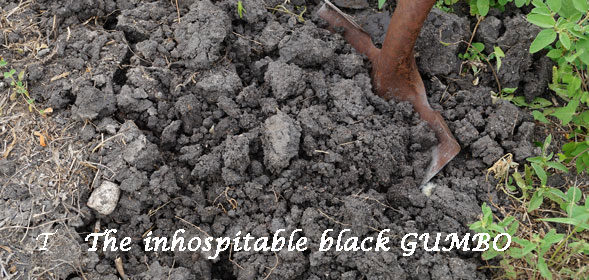Drat, that dirt

It is called “gumbo”.
No, it is not anything you can eat, at least not directly, not even with chicken and sausage.
You grow things in it.
Well……maybe.
At a distance it looks black, closer it’s dark gray.
[See the stuff at the top of this piece.]
When it rains a lot, and you first-time-ever step into it – slurp – you’ve just been introduced to stubborn goo. It absorbs water quickly, yet the sticky clay particles immediately bond and cause runoff.
But the frogs, turtles and birds love what the soil creates: opportunistic ponds to become like days at the beach.
Wheeee!
Yet as soon as moisture leaves the soil quickly dries, hardens and cracks the likes of which can impede a small dog. [Only a slight exaggeration.] The wet-dry clayey technical term is “elastic” or- for the common person -“expansive”.
Then there is the guy who is trying oh so hard to simply farm it.
Yes, grow things: cultivate, plant seeds, fertilize, water, care for and harvest. And to do that organically, naturally, without chemicals or miracles-to-grow.
Well….maybe.
For example, my version of this spring’s south-central Texas harvest wasn’t. All the arduous, preparatory work yielded stunted, pathetic corn and potatoes. [Too embarrassed to show that picture.]
Oh, but wait, a test patch of globe radishes in a raised bed did well. Can man live on radishes alone?
To be discouraged is never to be defeated.
We’ll just write off local, first-growing season 2014.
Although steamy, soggy summer has now arrived, Plan B for a fall – August – planting is taking shape, founded on lessons learned.
The early settlers of Texas were enticed to come here by the opportunity to have their own piece of dirt: work hard, homestead, farm, and raise a family.
For many sod-busters the reality was daunting.
And gumbo is no different now than back in the 1800’s.
But there is great comfort and optimism knowing that we are so much smarter, savvier today.
Well…………maybe.
In the Northern part of Australia where we have two seasons, wet and dry – our dirt turns to mush during the wet, is trampled by animals such as cattle and kangaroos before hardening to a similar texture of ankle twisting chaos that the locals refer to as “devil-devil country”. From the air this looks like a smooth brown paddock as the dead grass blown over by the south-easterly winds hides the hardened turmoil that exists beneath.
Brothers in arms in the battle to bring green life out of unforgiving dirt.